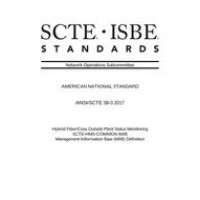SCTE 133 2017
- Downstream RF Interface for Cable Modem Termination Systems
- standard by Society of Cable Telecommunication Engineers, 2017
- Category: SCTE
$50.00
$25.00
This document defines the downstream radio-frequency interface [DRFI] specifications for:
•an edgeQAM (EQAM) modular device, or
•an integrated Cable Modem Termination System [CMTS] with multiple downstream channels per RF port, or
•an integrated CMTS beyond DOCSIS 2.0.
There are differences in the cable spectrum planning practices adopted for different networks in the world. Therefore two options for physical layer technology are included, which have equal priority and are not required to be interoperable. One technology option is based on the downstream multi-program television distribution that is deployed in North America using 6 MHz channeling. The other technology option is based on the corresponding European multi-program television distribution. Both options have the same status, notwithstanding that the document structure does not reflect this equal priority. The first of these options is defined in Sections 5, 6, 7, whereas the second is defined by replacing the content of those sections with the content of Annex A. Correspondingly, [ITU-T J.83-B] and [CEA-542-B] apply only to the first option, and [EN 300 429] only to the second. Compliance with this document requires compliance with the one or the other of these implementations, not with both. It is not required that equipment built to one option shall interoperate with equipment built to the other.
A DRFI-compliant device may be a single-channel only device, or it may be a multiple-channel device capable of generating one or multiple downstream RF carriers simultaneously on one RF output port. An EQAM may be a module of a modular cable modem termination system (M-CMTS) and be used for delivering a high-speed data service or it may serve as a component of a digital video or video-on-demand (VOD) system, delivering high quality digital video to subscribers. These specifications are crafted to enable an EQAM to be used without restriction in either or both service delivery scenarios simultaneously. ?Simultaneous? in the early deployments means that if a RF output port has multiple QAM channels, some channel(s) may be delivering high-speed data while some other channel(s) may be delivering digital video. This specification enables future uses, wherein a single QAM channel may share bandwidth between high-speed data and digital video in the same MPEG transport stream.
Conceptually, an EQAM will accept input via an Ethernet link, integrate the incoming data into an MPEG transport stream, modulate one of a plurality of RF carriers, per these specifications, and deliver the carrier to a single RF output connector shared in common with all modulators. Conceivably, a single EQAM RF channel could be used for data and video simultaneously. The reason that an EQAM RF channel can be used for either is that both digital video and DOCSIS data downstream channels are based on ITU-T J.83 Annex B [ITU-T J.83-B] for cable networks in North America and EN 300 429 [EN 300 429] for cable networks deployed in Europe. On downstream channels complying to ITU-T J.83, Annex B, typically, the only difference between an EQAM RF channel operating in a video mode and an EQAM RF channel operating in DOCSIS data mode is the interleaver depth (see Sections 6.3.1 and 6.3.3). DOCSIS data runs in a low latency mode using a shallow interleaver depth at the cost of some burst protection. DOCSIS data can do this because if a transmission error occurs, the higher layer protocols will request re-transmission of the missing data. For video, the sequence of frames in the program is both time sensitive and order sensitive and cannot be re-transmitted. For this reason, video uses a deeper interleaver depth to provide more extensive burst protection and deliver more of the program content without loss. The penalty video pays is in latency. The entire program content is delayed by a few milliseconds, typically, and is invisible to the viewers of the program. The conflicting demands for interleaver depth are what prevent a single EQAM RF channel from being used optimally for video and DOCSIS data simultaneously. A traditional integrated CMTS, however, is used solely for DOCSIS data.
 PDF
PDF
All of our standards document are available in PDF (Portable Document Format), an electronic, downloadable format.You will be able to download the file in your account downloads.
 Multi-User Access
Multi-User Access
After purchasing, you have the ability to assign each license to a specific user.
 Printable
Printable
At any time, you are permitted to make printed copies for your and your members' reference use.





